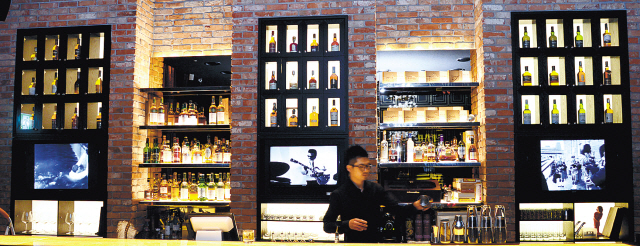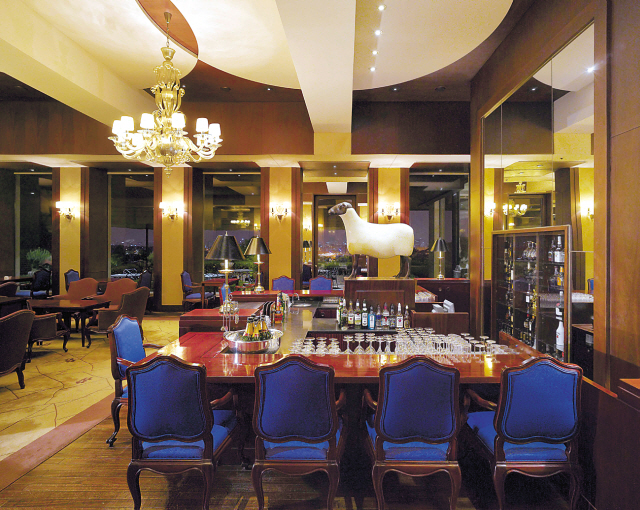 |
B28, which first opened in Singapore in 2011 and expanded to Seoul this March, does not only specialize in single malt whisky. The Cheongdam-dong bar also has nine single cask whiskies available. (Park Hyun-koo/The Korea Herald) |
The increased local popularity of single malt whisky is no industry secret. Since major drinks business Diageo Korea started importing single malt whisky in 2006, the niche market has seen a boom.
According to brand manager Ma Hyung-min, sales of Diageo’s single malt whiskies have exceeded double-digit growth every year. The portfolio has expanded from just one to more than 20 single malt whiskies now.
Single malt is even weathering the economic downturn.
Diageo’s single malt whisky saw a 16 percent increase in sales from 2010 to 2012, according to Ma, who sees great potential in the trend.
“It looks like the trend, which is developing in some hotel bars and spots in Hannam-dong, will spread throughout Seoul and also throughout the nation,” said Ma.
 |
Grand Hyatt Seoul’s The Paris Bar, one of the earlier bars to specialize in single malt whisky, opened in 1994. (Grand Hyatt Seoul) |
The Paris Bar, which opened in the Grand Hyatt Seoul in 1994, is one of the earlier bars to specialize in single malt whisky.
Grand Hyatt Seoul assistant food and beverage director Alistair Minty, who sees the single malt trend as still “relatively young,” believes that “people are starting to understand the different regions.”
Regions, apparently, play a role in helping one grasp single malt whisky. According to Mike Soldner ― who co-owns single malt bar B28, which first opened in Singapore in 2011 and then expanded to a second outlet in Seoul this March ― the charm of single malt scotch is that it is “geographically specific.”
While single malt whisky is also made outside of Scotland, when it boils down to talk of regions, connoisseurs are referring to scotch.
“There are six primary regions within Scotland,” Soldner explained. “The largest producing region is Speyside.”
Located in northeastern Scotland, Speyside, according to Soldner, boasts 40 to 50 active distilleries and is home to global top-sellers like Glenfiddich and The Macallan.
 |
Scotland has six major single malt regions: Speyside, the Highlands, the Lowlands, Islay, the Islands and Campbeltown. (Diageo Korea) |
 |
Diageo Korea currently boasts a portfolio of more than 20 single malt whiskies. (Diageo Korea) |
“Speyside is your rich and rounded whisky,” Soldner gave a general description of what to expect.
“Speyside is quite a good region to start with,” said Grand Hyatt’s Minty, who added that single malts from Speyside are popular at The Paris Bar.
The Highlands, which encompasses most of Scotland, gives rise to whisky that can be “more floral” with a “light sweetness,” said Soldner, who went on to describe whisky from the southernmost region, the Lowlands, as “light and superbly drinkable.”
Then, of course there is Islay, the largest whisky-producing island in Scotland, whose whisky is known for its peated flavors and is “famous for being full-bodied and smoky.”
The remaining two regions are the Islands, which are basically all the other remaining whisky-producing islands in Scotland, and then the southwestern coastal region, Campbeltown.
Soldner describes whisky from the seaside Campbeltown as generally boasting flavors of “salt and citrus, often with a little bit of smoke.”
Given that each single malt hails from one distillery, it makes sense as to why regional characteristics serve as a basic guideline to seek out a whisky of choice.
For instance, fans of peated scotch are likely to look toward distilleries in Islay, whereas those who want something light might seek out a distillery in the Highlands or Speyside.
Regions, however, are a basic guideline. If one wants to go one step further, then there is single cask whisky.
“Single cask is super limited,” said Soldner, who explained that “single cask” means that the whisky comes from one specific barrel.
“The average barrel will yield on average 300 bottles maximum and one will never have two barrels that taste exactly the same.”
For instance, at B28 one can find truly rare Banff 1975 single cask whisky.
“Banff closed in 1983,” said Soldner. “It will never produce whisky again.”
The mere idea of sipping at a snifter full of a near-extinct libation, of participating in its demise while simultaneously having the privilege of tasting it before it disappears is thrilling in itself, and that, of course, is one of the charms of a single malt.
As Soldner aptly put it, one of the charms of single malt is “its limited quantities.”
Details
B28; Basement 88-2, Cheongdam-dong, Gangnam-gu, Seoul; (010) 3402-2828; www.BTwentyEight.com; open 7 p.m. to 4 a.m. daily; single malt whisky by dram (40 ml) costs 14,000 won to 465,000 won; 10,000 won cover charge
The Paris Bar; Lower Level 1 of Grand Hyatt Seoul, 322 Sowol-ro, Yongsan-gu, Seoul; (02) 799-8361; seoul.grand.hyattrestaurants.com; open 5:30 p.m. to 1 a.m., open till 2 a.m. Fridays and Saturdays; single malt whisky by the glass (45 ml) costs 23,000 won to 295,000 won, single malt flight costs 73,000 won
By Jean Oh (
oh_jean@heraldcorp.com)







![[Herald Interview] 'Trump will use tariffs as first line of defense for American manufacturing'](http://res.heraldm.com/phpwas/restmb_idxmake.php?idx=644&simg=/content/image/2024/11/26/20241126050017_0.jpg)

![[Health and care] Getting cancer young: Why cancer isn’t just an older person’s battle](http://res.heraldm.com/phpwas/restmb_idxmake.php?idx=644&simg=/content/image/2024/11/26/20241126050043_0.jpg)

